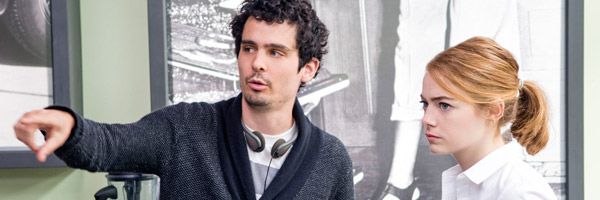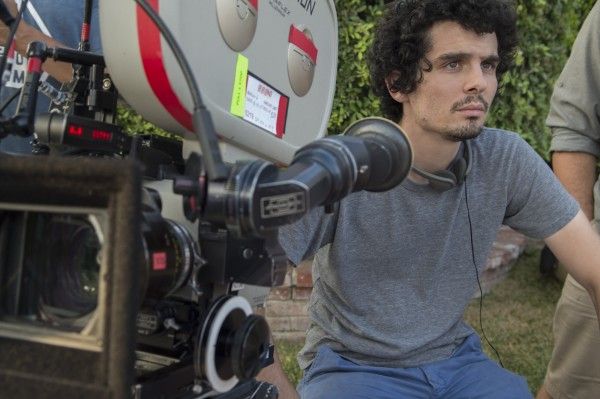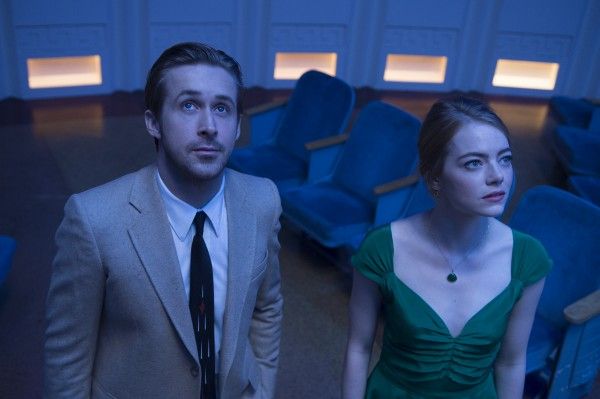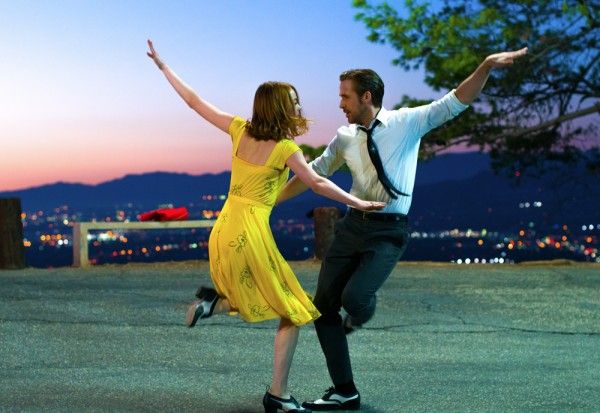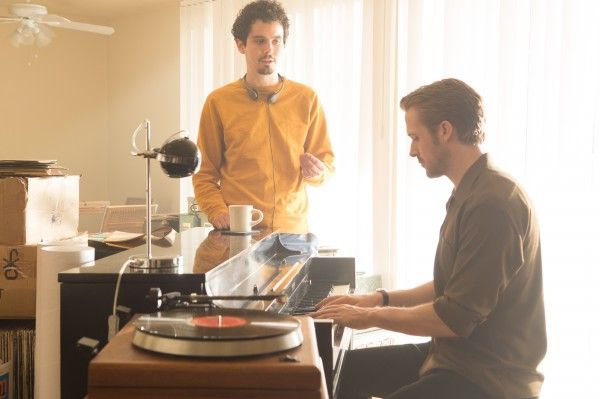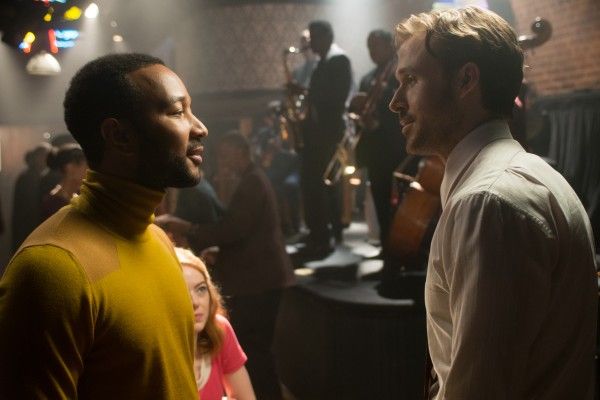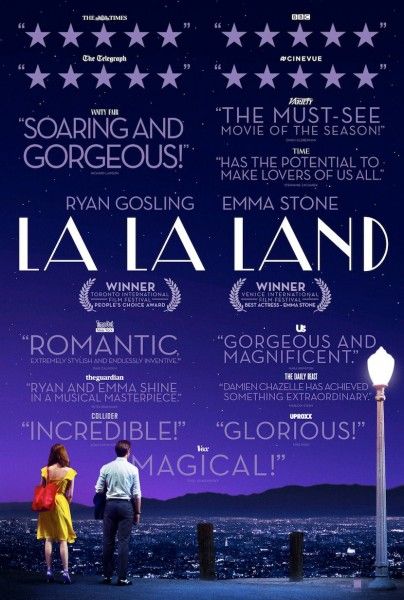From writer/director Damien Chazelle, the musical La La Land is a beautiful love letter to Los Angeles about a jazz pianist (Ryan Gosling) who falls in love with a hopeful actress (Emma Stone). Over the course of their life-changing love affair, the two go on a song-and-dance journey that is both an ode to the glamour of classic cinema and a modern desire to fulfill one’s dreams.
During a roundtable at the film’s Los Angeles press day, filmmaker Damien Chazelle talked about how many years it took to get La La Land off the ground, when and how he fell in love with Los Angeles, the process of picking the film’s locations, the old school techniques he used during filming, shooting on a freeway ramp, the qualities that Ryan Gosling and Emma Stone brought to these characters, and how his background in music inspires his films.
Question: So, did it really take you six years to get this film made?
DAMIEN CHAZELLE: Yeah, from the moment that I wrote it, just to get it off the ground and get the money for it. It wasn’t an obvious sell to Hollywood. It was a step by step process. Ultimately, making Whiplash, my earlier movie, helped open some doors that we were able to pounce through, before they closed again. That’s how we got it off the ground.
You clearly love music and you love film. When did you fall in love with Los Angeles?
CHAZELLE: That took a little longer. I grew up on the east coast. L.A., to me, was the action movies I was watching, as a kid in the ‘90s. It was Speed, Terminator and Volcano. It was this concrete jungle that seemed entirely unliveable, compounded with the east coast snobbery about L.A. So, I moved here very hesitantly. I really just moved here because of movies and feeling like, “I’ve gotta at least try it out and see.” I was uneasy here at first, and I felt a little isolated, and then I fell deeper and deeper in love with the city. It was a late-blooming love affair with the city, as I discovered that it’s so much more than what I thought it was. Part of what I love about it and wanted to capture here is the way it reveals itself slowly to you. It’s not the best city for visitors because it doesn’t give you everything on a silver platter, the way that New York or certain European cities do. You have to search a little bit more in L.A. That can be frustrating, but it can also be really rewarding.
How did you pick the L.A. locations that you used?
CHAZELLE: Some of the stuff was written into the script, at an early stage, because they were just things I, personally, loved in L.A. And then, a lot of the stuff came through once we started scouting. We had a great production designer, David Wasco, who’s lived in L.A. all of his life, but he’s also designed some of the iconic L.A. movies of recent years. He did Pulp Fiction and Jackie Brown, and he did Collateral. He has a certain view on the city, and he knew these spots and little nooks and crannies that he would take us to, that I loved discovering. Scouting was this wonderful process of not just figuring out where we would be shooting stuff, but also learning more about my own city, which I really loved. So, there were certain things that, at the outset, I was very certain that I wanted to celebrate, like Griffith Observatory and iconic sites like that. There were also iconic sites that I wanted to steer away from, like the Hollywood sign, that I have no problem with, but I felt like we’d seen enough in movies recently. And then, it was this process of discovery. Whenever we would find a location, sometimes we’d have to do little touches, like add a street lamp, or shoot it at a certain time of day, or paint a wall, just to give it a little extra magic. We wanted to have that combination of the grittier, real location with the little bit of pixie dust that we could add.
What old school techniques did you use, in making this?
CHAZELLE: I don’t know if you’d call it old school, but we shot on film and we shot on the native 2.55 ratio, which is the old Cinemascope ratio. And then, I wanted to indulge in my favorite old devices, like iris fade-outs, multiple exposures, and stuff like that. The thing that we tried to do the most was to do stuff in camera and do it practically, and not really rely on a ton of CG or post-production work. If the sky was a certain color at night, we wanted to capture that color. Even if it meant we had to shoot a number within a half-hour window, then that’s just what we had to do. With the opening freeway ramp, we wanted to make sure we did that on an actual freeway ramp and not in a studio where we could then CG green screen. So, we tried to limit the amount of CG visual effects, as much as we could. And towards the end, we used painted backdrops. That was another thing that I was really excited to do. In old Hollywood, there was more of an acceptance of stuff being obviously fake, and reveling in that, as opposed to trying to fool the eye. I loved that.
Since it is something brought up in this film, how do you stay true to your integrity while also moving with the times? Where is the line between artistry and commercialism?
CHAZELLE: I love the old musicals, I love jazz, and I love all these things that the modern world tells us are marginalized now or outdated. What do you do, as a lover of older forms? Do you try to push them to modernity at the risk of bastardizing them, or do you try to preserve what you feel is their essence at the risk of making them even more marginalized? It can apply to almost any art form, even movies, in general. We talk today about, what’s happening to movies? Movies are dying. I obviously don’t believe that. But, it is a universal question, among any art form. I don’t necessarily have an answer. I just thought it was interesting to enact that debate.
People say that pursuing your dream is a luxury for people in their 20s and 30s because, as you grow older, you have more responsibilities. How do you feel about that? Is pursuing your dream something only for the young?
CHAZELLE: No, I don’t think so. At least in the case of this movie, it’s hard to be trying to pursue your dream, at the same time you’re trying to figure out what that dream even is. These characters are examples of people who are very set on a goal and they’re going after that goal, but the actual specifics of that goal are open to shifting. They’re still figuring out who they are and they’re still figuring out what kind of artists they want to be, and that’s a good thing. On the one hand, that’s a good thing. You catch them at a period in their life when there’s still this openness to change. But on the other hand, it creates even more uncertainty. Going through that sort of shift, while being with and without another person and while being in a city like L.A., if there was one emotion I wanted to capture in the movie, it was that state of constant uncertainty and self-doubt. Even if you project a lot of confidence about what you’re going to do, deep within, you’re constantly asking yourself, “What am I doing?”
What was it like to shut down and shoot on the 105 freeway ramp? Did you do that on the weekend?
CHAZELLE: It was a weekend, yeah. It was crazy. We did a location scout, well before shooting there, just to see if it made sense as a place to shoot, and that was in the middle of the night. They were able to shut down that ramp for an hour, for us to just stop and get out. It was my first time ever being on a shut down freeway. I remember stopping the car on the ramp and getting out, and I was really nervous. It’s weird, opening up the door and stepping onto a freeway ramp. But I did want to shoot there because it gives you that panoramic view that gives you as good of an opening vista as you can ask for. And practically speaking, because it’s just this ramp, and it’s an easy pass ramp normally, we were able to convince the city. It was easier to shut down than shutting down an actual chunk of the freeway itself.
How long did you shut it down for?
CHAZELLE: For a weekend – Saturday and Sunday.
How do you feel that your background in music has affected your filmmaking?
CHAZELLE: It’s definitely lent itself to the subject matter of a lot of these movies. I love, so much, what you can do with the combination of music and imagery, or music and film. With this movie and with my previous movies, I love the idea of trying to say as much as you can without dialogue, or use dialogue, but use it to get yourself, emotionally, to a point where the imagery and the music can just takeover. Whether that comes from my own experience as a musician or my taste in movies, I’m not sure, but it is a part of filmmaking where I feel the most energized and inspired. I love getting more abstract and letting those things do the lifting.
What qualities did Ryan Gosling and Emma Stone bring to their roles that made them perfect for this?
CHAZELLE: I think they’re timeless movie stars, in that old fashioned movie star way, in terms of their screen presence and the way the camera loves them. But I also think that they have these interesting edges that make them very human, and I really like that. Ryan has this very, very modern style of acting that’s very not old Hollywood, that makes for an interesting combination. And Emma is able to shift between different registers. She has this brash comic persona, but yet, with her eyes, she’s incredibly vulnerable, as an actor. You can really feel her heart beating. If I had to boil it down, they both seem to link old Hollywood to new Hollywood.
How did you get John Legend on board?
CHAZELLE: I met him initially when I was doing the rounds for Whiplash and he was doing promotion and campaigning for Selma, which he won the Oscar for, for his song. So, we met up during a couple of those brief run-ins. And then, about a year later, when I was casting for this movie, he was on my mind. At that point, I had developed a little bit of a relationship with a producing partner of his, so we started talking. I think because we had that prior connection, it was actually a pretty easy thing to sell him on. He was just like, “Okay, cool!” He showed up and it was really fun. Working with Ryan [Gosling], John was excited and intimidated by an actor like Ryan, and Ryan, playing a musician in the movie, was really excited and intimidated by a musician of John’s caliber being there with him. They both wanted to be on top of their games with each other. It was actually really fun, the scenes we got to do with both of them. They were great together.
La La Land opens in New York City and Los Angeles on December 9th, and nationwide on December 16th.

